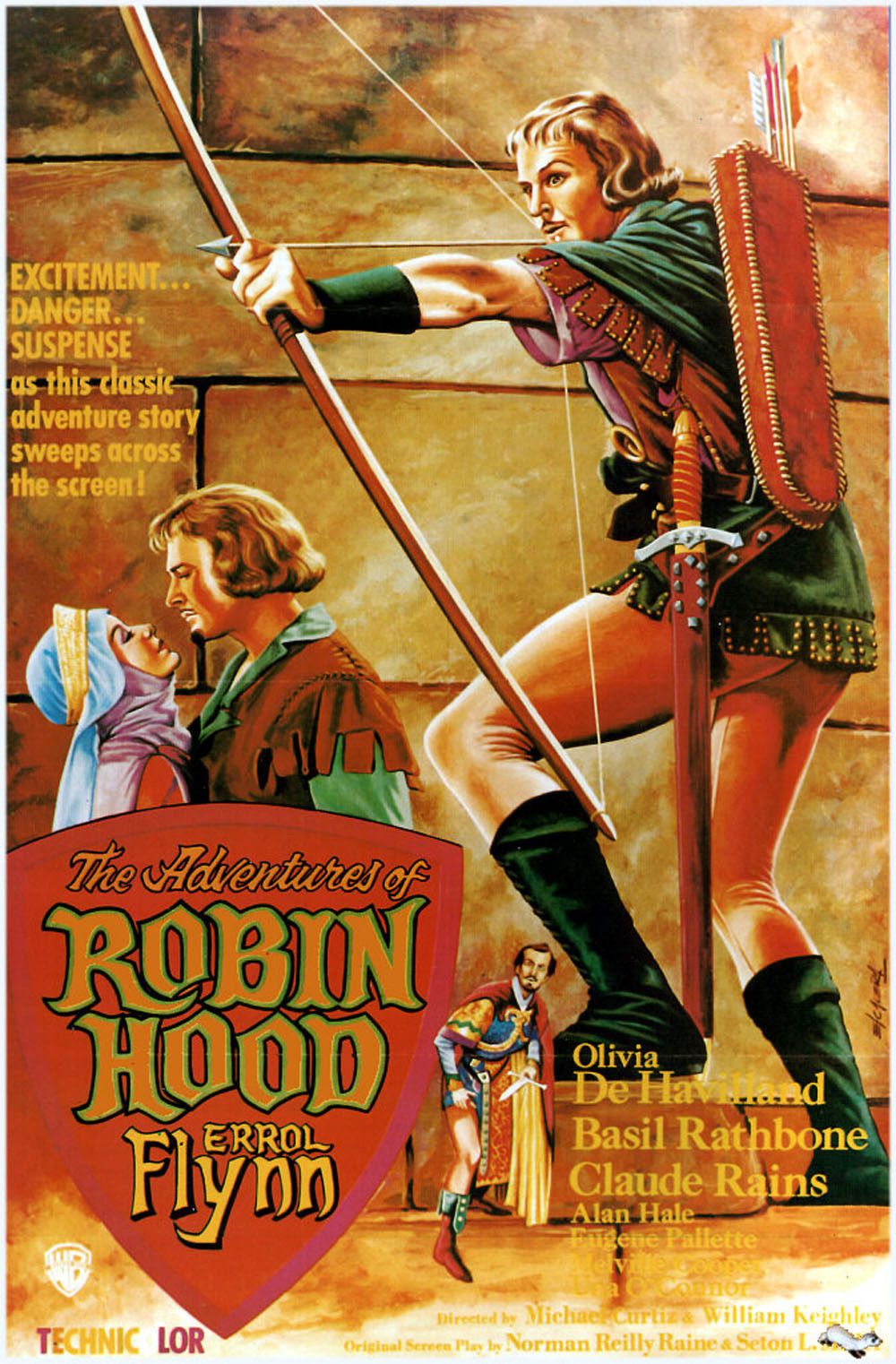Introduction
Made for $2,000,000 ($35,000,000 adjusted for inflation), shot in Technicolor, and released in 1938, The Adventures of Robin Hood was the most expensive movie produced by Warner Bros. up to this point, and it shows on the big screen. The extravagant production features outdoor location shooting, huge castle sets (for both interiors and exteriors), and truly fantastic costumes. Every bit of that $2,000,000 can be seen on the screen.
The cast of The Adventures of Robin Hood is top-notch. Errol Flynn, Basil Rathbone, Olivia de Havilland (who passed away in July 2020 at the age of 104), and Claude Rains lead the cast. However, everyone involved plays their respective roles as well as could be done, and the characters are all distinctive and memorable. One of the more impressive things about this film is that it goes into detail as to how England was two different groups of people. The Saxons, who were the common people. And the Normans, who were the ruling class. This goes back over a century, to the victory of William the Conqueror at the Battle of Hastings.
The Saxons respect “King Richard Plantagenet” because he is fair. This is despite his Norman lineage. However, the rest of the Norman rulers are not nearly as fair. When Richard is captured by “Duke Leopold” in Germany, on a return trip from the Crusades, his brother “Prince John” assumes control of England. Prince John subsequently taxes the Saxon commoners, allegedly to pay the ransom. However, this is misleading as the reality is that he is instituting these taxes to fatten his coffers. Sir Robin and a ragtag group of Saxons, including “Much, the Miller’s Son,” “Will Scarlet,” “John the Little,” and others, team up to stop them. Subsequently, they steal money from the Normans to pay Richard’s ransom. One other thing to be pointed out is that The Adventures of Robin Hood doesn’t shy away from Christianity. The film embraces these ideals, which were prevalent in both the period the story takes place in, as well as when the movie was produced. The genuineness of the film stands out. It clearly illustrates just how cynical current attitudes about faith and religion have become. Robin, as portrayed in the 1938 film is neither a pagan nor a “New Age Protestant.” Rather, he is a devout Catholic, loyal to his King and his God. The biggest problem The Adventures of Robin Hood faces is that the first 30 minutes are disjointed. Several title cards throughout try to explain what’s happening, instead of just showing you. This isn’t because of the age of the film, as other classics produced around this time like Gone With The Wind and The Wizard of Oz don’t suffer this flaw.The Saxons and Normans
A Ragtag Group
Analysis
The absolute best thing about The Adventures of Robin Hood is the action sequences, which are completely different than what modern audiences were used to at the time. Unlike other films of the day, the action scenes weren’t over-choreographed. It would be surprising if some of them had any choreography at all.
The way the action scenes were shot mostly looked like the director had said: “Jump out of these trees and attack the Normans on horseback” and “The Normans and Saxons have a big battle in this courtyard” and they just filmed it that way. These scenes are master shots, with a few close-ups tossed in. Also, incredibly, The Adventures of Robin Hood has only 3 or 4 shots that use actual stuntmen. The rest of the action was performed by the actual actors that were cast. This was right in Flynn’s wheelhouse, as he was a natural when it came to performing acrobatic stunt work in front of a camera. The most iconic action scene in the film is the ending sword fight between Rathbone’s “Sir Guy” and Flynn’s Robin. This legendary sword fight has been building for the entire film and it’s masterfully done. It rivals Flynn’s incredible swordplay in The Sea Hawk, released two years later in 1940. Again this isn’t overly choreographed like the sword fighting in the Pirates of the Caribbean, and it genuinely feels like the two actors were having a real sword fight (both took fencing lessons from legendary instructor Fred Cavens), with some props worked into the sequence.
Overall, I would recommend this classic take on the legend of Robin Hood. Despite its few shortcomings that take place in the early part of the movie, The Adventures of Robin Hood remains timeless and a lot of fun to watch.The Stunts
Conclusion
If You Enjoyed This Article We Recommend:
The Garden of Allah: Old Hollywood’s Hedonistic Home (Click Here)
Scholars’ Spotlight: Rudolph Valentino (Click Here)
Scholars’ Spotlight: Hedy Lamarr (Click Here)
Keep up with Cinema Scholars on social media. Like us on Facebook, subscribe on YouTube, and follow us on Twitter and Instagram.
